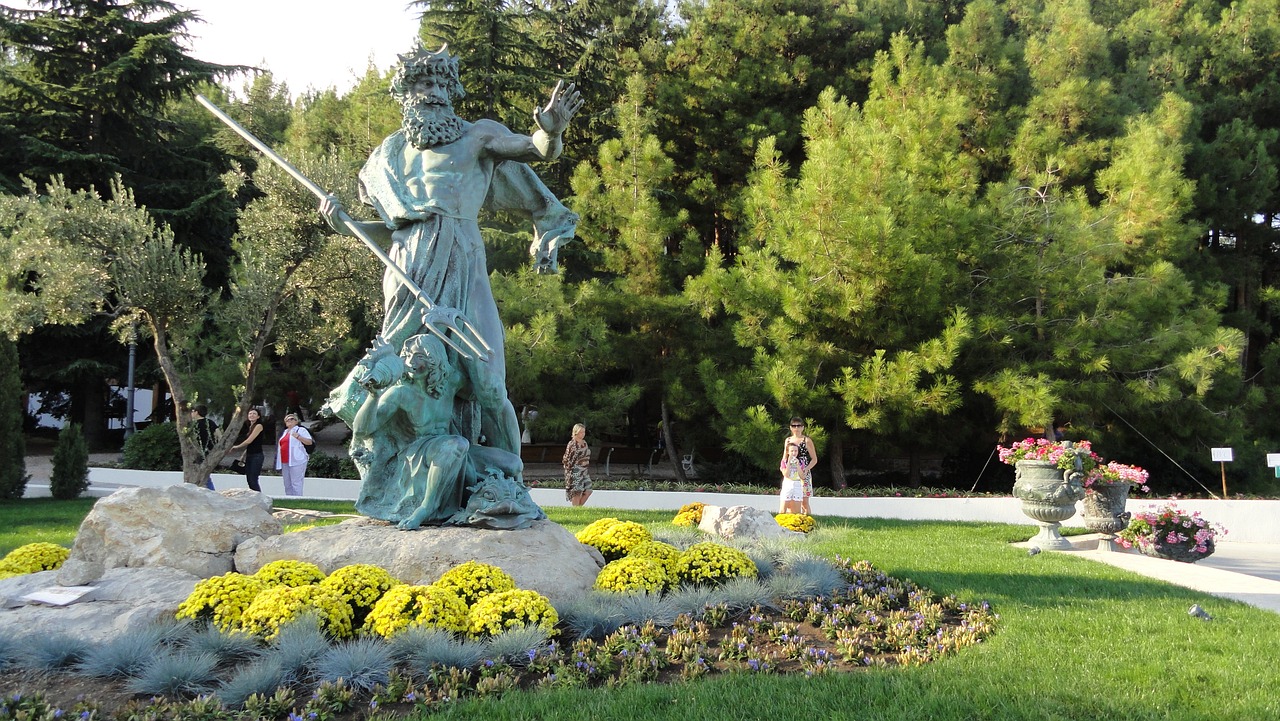The Olympian God of the Sea: Poseidon
Overview
Poseidon, an Olympian deity, presides over the sea, earthquakes, floods, and horses. He is typically envisioned as a robust, bearded man wielding a trident, symbolizing his authority over watery domains.
Myths and Legends of Poseidon
From his very beginnings, Poseidon’s existence was fraught with challenges; he was swallowed by his father Kronos at birth but rescued by Zeus with the assistance of the goddess Metis. In a series of conflicts known as the Titanomachy, the Kyklopes fashioned Poseidon’s magical trident, enabling him and his brothers to overcome the elder gods. After the defeat of the Titans, Poseidon drew lots for dominion over the cosmos and ended up ruling the sea.
During one notable episode involving the Gigantes, Poseidon famously defeated the giant Polybotes by burying him under the island of Kos. When competing against Athena for the control of Athens, Poseidon offered the first horse as a gift, but upon losing the competition, he unleashed drought upon the land in retaliation. His passionate pursuits are also evident in his relationships, where he often transformed into various forms, including creatures of the sea, to seduce nymphs and mortal women. Among his well-known liaisons were Medusa, Tyro, and Aithra, the mother of Theseus.
In terms of construction, Poseidon played a role in building the mighty walls of Troy, but when denied promised compensation by King Laomedon, he unleashed a monstrous sea creature upon the land. The enduring enmity of Poseidon is illustrated by the repercussions faced by Odysseus after blinding his son Polyphemos, which led to Poseidon sending storms to disrupt Odysseus’s return journey from Troy.
Attributes and Symbols
The trident, an iconic three-pronged spear, is Poseidon’s most recognizable attribute, often appearing alongside a boulder surrounded by sea life. Artistic representations of Poseidon frequently depict him clothed in a flowing robe or sometimes nude, adorned with wreaths made from wild celery or bands around his head.
Sacred Animals and Flora
Poseidon is closely associated with several sacred animals: horses, bulls, and dolphins. His chariot, drawn by fish-tailed horses called hippocamps, exemplifies his dual role as both horse god and master of the seas. The Cretan Bull is among his most notable sacred animals. His sacred plants include the pine tree and wild celery, which were used in ceremonial crowns during his dedicated games at the Isthmus of Corinth.
Family Ties
Poseidon, the offspring of Kronos and Rhea, is notably connected to Zeus, Hades, Hera, Demeter, and Hestia. He married the sea nymph Amphitrite, daughter of Nereus, with whom he fathered the sea god Triton. Poseidon also fathered numerous children, including mythological figures such as the cyclops Polyphemos and various heroes and monsters, a testament to his vigorous and often tumultuous nature.
History of Worship and Cultural Significance
Often referred to as the “Earth-Shaker,” Poseidon commanded authority over the seas and was also feared for his capability to summon storms or calm turbulent waters. He is depicted as holding the earth in his grasp and shook it at will, earning him the epithet “Ennosigaios.” Historically, Poseidon had associations with the nurturing aspects of water and fertility, which eventually transformed him into the deity ruling over the oceans. His revered status manifested in various localities in ancient Greece, primarily in the Peloponnesus and coastal cities. Sacrificial offerings to Poseidon typically included bulls, accompanied by chariot races in his honor.
Culturally, Poseidon’s imagery is rich and varied in the arts, featuring in numerous ancient works alongside Amphitrite, Tritons, and marine creatures. Unlike Zeus, who is often represented as composed and majestic, Poseidon’s artistic portrayals capture his potent and unpredictable nature, reflecting the duality of both order and chaos present in the oceanic world.
Conclusion
Poseidon, as a mythological figure, embodies a powerful amalgamation of nature’s splendor and wrath. His legacy is woven deeply into the fabric of Greek mythology, exemplifying the profound respect and fear the ancient Greeks held for the sea and its tentacles of influence on civilization.



